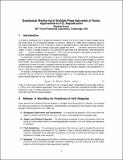| dc.contributor.author | Brown, Stephen | |
| dc.contributor.other | Massachusetts Institute of Technology. Earth Resources Laboratory | |
| dc.date.accessioned | 2014-09-29T19:26:28Z | |
| dc.date.available | 2014-09-29T19:26:28Z | |
| dc.date.issued | 2011 | |
| dc.identifier.uri | http://hdl.handle.net/1721.1/90449 | |
| dc.description.abstract | 4-D seismic techniques rely on measuring changes in velocity over time in order to detect changes during activities such as CO[subscript 2] flooding and storage in a reservoir. Wang et al. [1998] detail a laboratory study of the seismic detectability of CO[subscript 2] flooding in a series of carbonate reservoir rocks taken from the McElroy field, West Texas. The basic findings of the paper suggest that while “ . . . laboratory results show that the largest V[subscript P] and V[subscript S] changes caused by CO[subscript 2] injection are associated with high-porosity, high-permeability rocks, . . . ” velocity changes in low-porosity (< 10%) and low-permeability carbonates are less than 1% and are undetectable using traditional 4-D seismic techniques. | en_US |
| dc.language.iso | en_US | en_US |
| dc.publisher | Massachusetts Institute of Technology. Earth Resources Laboratory | en_US |
| dc.relation.ispartofseries | Earth Resources Laboratory Industry Consortia Annual Report;2011-09 | |
| dc.subject | AVO | |
| dc.subject | CO2 | |
| dc.subject | Fluid flow | |
| dc.title | Geophysical Monitoring of Multiple Phase Saturation of Rocks: Application to CO[subscript 2] Sequestration | en_US |
| dc.type | Technical Report | en_US |
